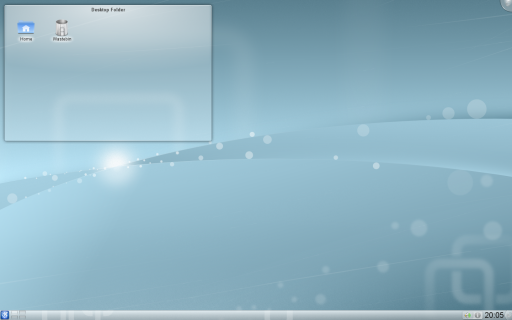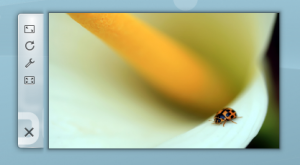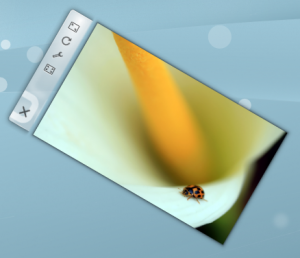Plasma
Bir Bakışta
Plasma, KDE çalışma alanıdır. Aslında, birçok aygıt türüne uydurulabilen bir teknolojidir. Şuan Plasma'nın üç çeşidi bulunmaktadır: Sayfalarımızın çoğunluğunun üzerine olduğu Plasma Masaüstü ortamı, Plasma Netbook ortamı ve tabletler ile akıllı telefonlar için yeni hoş bir ortam olan Plasma Active.
Normal bir Plasma masaüstü bunun gibi görünür:

Varsayılan bir Plasma Masaüstü'nün dört temel ana bileşeni:
- Bazen "görev çubuğu" olarak kullanılan panel, uygulama başlatıcı, pencerelerin listesi (programlar), saat ve sistem çekmecesi için boşluk sunar.
- Masaüstü, araç ve simgelerin içinde bulunduğu alandır.
- Klasör görünümü, bilgisayarınızdaki bir klasör içeriğini gösteren bir araçtır ve temel dosya yönetim görevlerine hızlı erişmenizi sağlar.
- Plasma araç kutusu, ekranın sağ üstünde ve panelin sonunda görülür. Bunlar, yapılandırma ve diğer seçeneklere kolaylıkla ve güvenilir bir biçimde erişmeyi sağlar.
Bu varsayılan öğelerin tümü tamamen yapılandırılabilir ve geniş aralıktan seçilebilecek araç ve içeriklere ev sahipliği yapabilir.
Plasma Masaüstü SSS
Plasma Masaüstü'nün geçerli sürümündeki "Sıkça Sorulan Sorular", bu sayfada yönetilmektedir. Bu sayfa, ortak sorulara kısa cevaplar verirken, önceki sürümlere de SSS bağlantılarını gösterir.
Plasma içerisinde yolunuzu bulma
Plasma'yı kullanmaya diğer işletim sistemlerindeki gibi masaüstünü kullanarak, uygulama başlatıcısına erişerek, şuan çalışan etkin programları görev çubuğunda görüntüleyerek, sistem çekmecesindeki simgelere erişerek ve benzeri işlemlerle başlayabilirsiniz.
Plasma'nın önemli bir kullanım parçası "gereçler"dir. Gereçler, masaüstünün bireysel birimleri olup, uygulama menüsü, simgeler, sistem çekmecesi, saat vb. gibi (ancak bunlarla sınırlı değil) uygulamaları içerir. Araçlar, masaüstünün kendisinde bulunabilir, panele eklenebilir, ekran koruyucusu olarak veya gösterge panelinde kullanılabilir. Gereçler, alışılmış masaüstü yardımcılarının yanında birçok görev için bulunabilir. Örneğin mikrobloglama (Twitter, ideti.ca), birim dönüştürme hesap makineleri, hava durumu tahminleri, dosya paylaşımları ve daha fazlası. Panel ve masaüstleri de diğer araçları içermek anlamında özel çeşit gereçlerdir.
Bu masaüstü kullanımıyla nasıl bağlı olmaktadır? Plasma'nın alışılmış masaüstü kullanımına saygı duyan bazı yeni özellikleri vardır. Plasma araç kutularından zaten bahsettik: Plasma Masaüstünüzü özelleştirme ve etkileştirmeye başlamanın yolları. Üzerlerine tıklamak, çeşitli seçenekler gösteren bir menü açacaktır: buradan panelinize veya masaüstünüze gereçler ekleyebilir, boyutlandırabilir, panel ekleyip kaldırabilir, arkaplanı değiştirebilir ve diğer işlemleri yapabilirsiniz.
Klasör Görünümleri
Yukarıdaki ekran görüntüsünde farkedebileceğiniz gibi, masaüstünüzde doğrudan yerleştirilmiş bir simge bulunmuyor. Bunun yerine, "Klasör Görünümü" adı verilen bir biriktirici içersine yerleştirilir. Varsayılan olarak Klasör Görünümü, Masaüstü klasörünü gösterir ve üzerine dosya sürüklemenize, açmanıza, kesme, kopyalama, yapıştırma, adlandırma işlemleri yapmanıza ve yeni klasörler/dosyalar oluşturmanıza izin verir.
Masaüstünüzde birden fazla Klasör Görünümüne sahip olabilirsiniz. Bu durumda panellerin içerisine yerleştirileceklerdir. Klasör Görünümünü, yerel veya uzak, erişime sahip olduğunuz herhangi bir klasör görüntülemek üzere ayarlayabilirsiniz. Her Klasör Görünümü, tercihinize göre bağımsız olarak taşınabilir ve boyutlandırılabilir.
Klasör Görünümü aynı zamanda varsayılan tam ekran arkaplanı olarak ayarlanarak, alışılmış "masaüstüne yayılmış simgeler" yerleşimi kullanılabilir.
Paneller

Paneller, ekranın kenarlarına gereçler yerleştirmenizi sağlar. Bu gereç koleksiyonları, otomatik olarak kullanımda olmadığında gizlenecek veya ekranın belirli alanlarına hizalanacak gereç yapılandırmalarını çeşitli yollarla ayarlamanıza izin verir.
Varsayılan olarak, ekranın altında bir panel bulunmaktadır, fakat daha fazla panel ekleme, taşıma ya da varsayılan paneli ekleme veya istemediklerinizi kaldırma gibi seçenekleriniz de mevcut. Panellerin tümündeki gereçleri göz zevkinize göre de ayarlayabilirsiniz.
Plasma Masaüstündeki panelleri yapılandırma hakkında bilgi almak ve sizin için neler yapabileceğini görmek için Plasma Panelleri sayfasını ziyaret edin.
Gereçler

Plasma supports widgets written specifically for Plasma (also known as Plasmoids) as well as widgets from other sources such as Google Gadgets, Superkaramba and some Dashboard Widgets from Mac OSX. Additional widgets can easily be found and installed through Get Hot New Stuff.
To see the widgets that are installed on your system and ready to use open the Plasma Widget Explorer by either
- opening the Desktop Toolbox in the upper right corner of the screen and selecting ,
- opening the Panel Toolbox furthest to the right in the Panel and selecting , or
- right clicking on the Desktop and choosing from the context menu.
To place a widget on the Desktop simply drag it from the Wigdet Explorer to the Desktop. To place a widget in the panel first open the Panel Toolbox and from there open the Widget Explorer (click ), locate the widget you wish to add and drag it to the desired position in the Panel.
Widgets that are docked into a panel usually have an Options menu, while those on the desktop have the configuration options within the 'handle', the shaded area which pops up when hovering over the widget. Clicking and holding the mouse on the blank part of the handle will allow you to drag the widget to the desired position.

You have four tools on this handle. The top one is the re-sizer. Click and drag on the tool to resize the widget.
The second tool is a rotate tool. Again, click and hold the tool, while rotating to the desired angle.

The third is the wrench or spanner which allows you to configure that particular widget's settings.
Finally, the fourth tool is the "expanded view" tool and is available only on widgets that support this feature, such as the Picture Frame or Web viewers. When clicked, the Picture Frame widget will, for example, open the currently viewed in an image viewer while the Web Slice widget will open the web page in a full web browser window.
A list of Plasma widgets with their own page can be found here, and some of our favourite widgets are discussed on the Plasma Widgets page
Activities
The icons shown in the screenshot have small buttons in the top right and bottom right. The small pause button in the top right prevents the activity from being included when switching through Activities using Super + Tab. It also opens up an "x" to delete the activity. To change the names of the activities, look for the small wrench in the bottom right of the icon.

Use Cases
A user likes web comics so they add their favorite web comics via the comics widget. The user now has a full desktop activity dedicated to their favorite web comics. Now the user is happy with the web comics, but the user now has to go to work, so the user creates an activity with the folder view widgets set to the folders of the projects the user is currently working on. After work the user goes home and works on a side project of writing romance novels. The user always gains inspiration by looking at pictures of the user's significant other. The user now creates a new Activity but now puts pictures frame widgets with pictures of the user's significant other. The user also has a folder view of the romance novel project folder. Now no matter what the user is doing the user has a custom tailored activity to match it.
Go to this blog to read a few tips on using activities. Chanis blog has a number of examples as well as screencasts about activities.
Widget Layouts and Virtual Desktops
Virtual desktops, the ability to have a separate sets of windows on separate desktops, can tie in with Activities. You can have a different activity on each virtual desktop. In Plasma Desktop 4.4, this can be configured by entering and navigating to , and checking .
In Plasma Desktop 4.3, You configure this by zooming out and choosing . Then select and zoom in again.
Hints and Tips
Tweaking Plasma
- Learn how to add a sidebar with clock and news
- Customize your Plasma by mixing multiple Plasma themes
Reloading Plasma
Sometimes you might want to reload Plasma, like right after changing system language so the changes takes effect, or because of a problem with the desktop. To do that, open a terminal and run these commands:
kquitapp plasma-desktop
plasma-desktop
Further information
- The Plasma FAQ's
- Plasma HowTo's - short screencasts
- Glossary
- Some of our favourite plamoids - why not add yours?
- Here's how to install more Plasmas widgets
- Learn the versatility of KRunner
| Back to the Introduction page |

